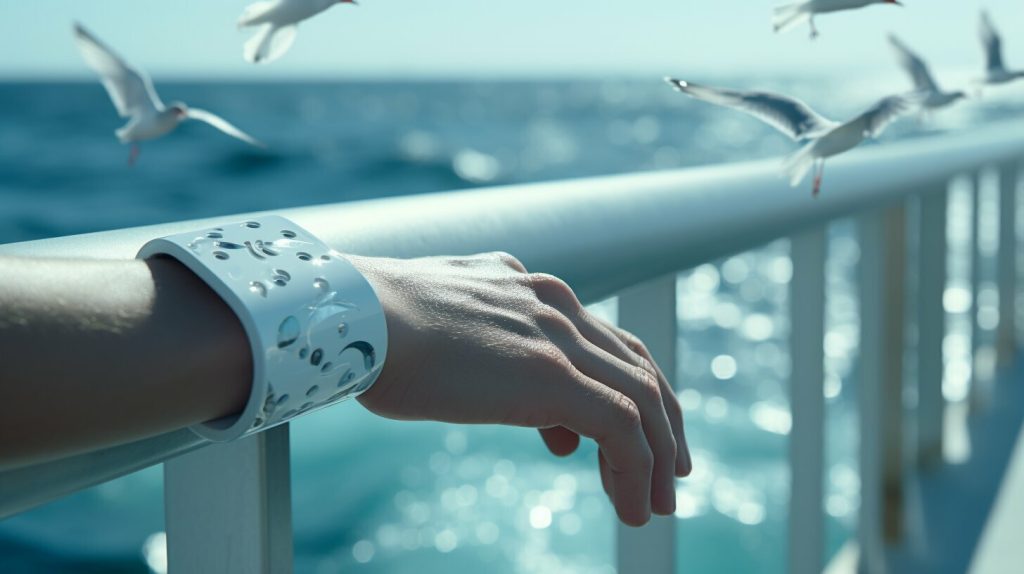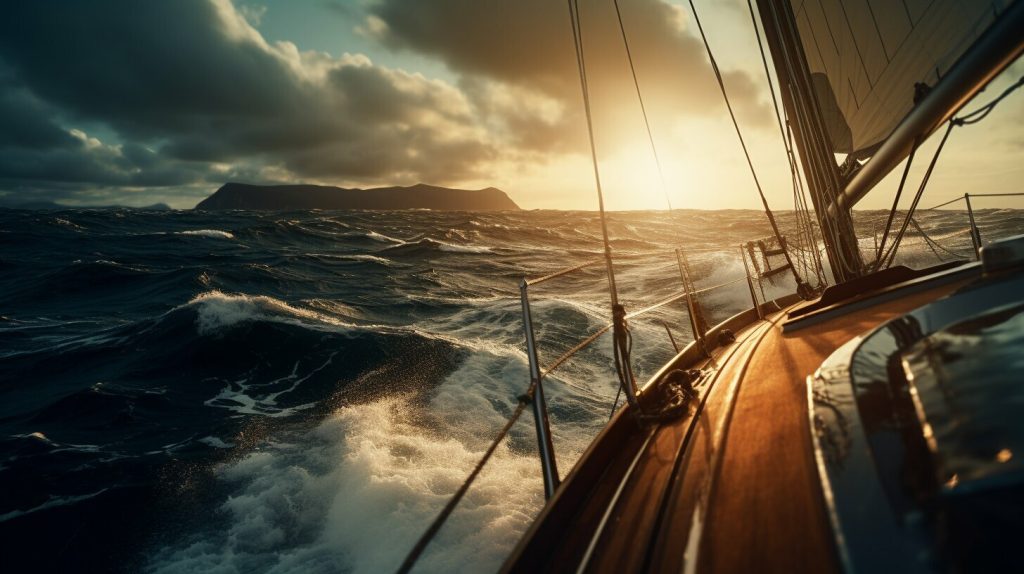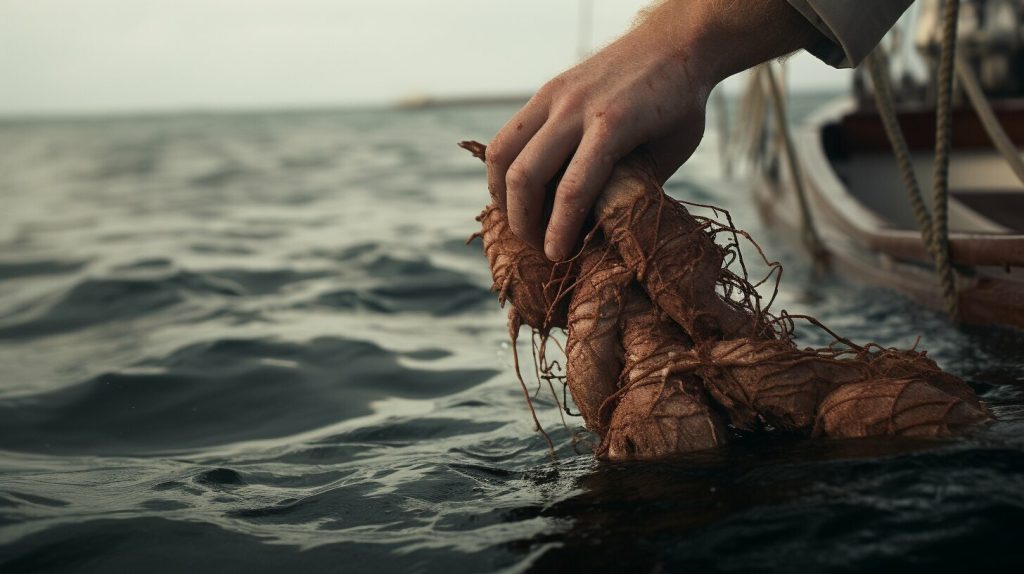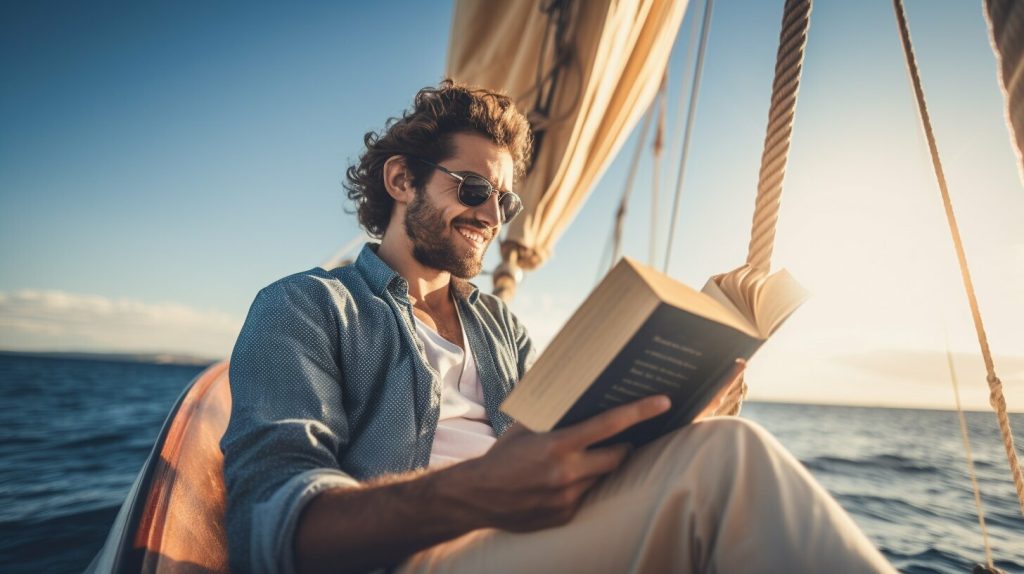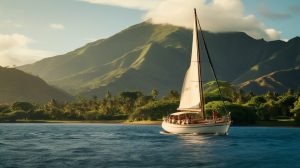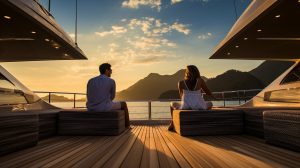If you love the idea of sailing but dread the thought of feeling queasy on the open seas, fear not! We’ve got you covered with these foolproof tips on how to avoid sea sickness while sailing.
Seasickness is a common problem for many sailors, but there are ways to prevent or minimize its effects. By following some simple techniques and natural remedies, you can enjoy a smooth sailing experience without the discomfort of seasickness.
Key Takeaways:
- Fool yourself into believing you don’t get seasick. The placebo effect can trick your brain into feeling fine on the waves.
- Keep your eyes on the horizon. Focusing your gaze on a fixed point can help maintain balance and reduce seasickness.
- Avoid bad smells. Unpleasant odors can trigger seasickness, so be mindful of your surroundings and take measures to control the smell.
- Stay away from seasick individuals. Being around others who are experiencing seasickness can increase your own chances of feeling queasy.
- Watch what you eat and drink. Avoid heavy or greasy meals before sailing and opt for light snacks. Stay hydrated throughout your journey.
By implementing these seasickness prevention tips, you can navigate the waters with confidence and enjoy your sailing adventures to the fullest. Remember, finding what works best for you may require some trial and error, so don’t be discouraged if one method doesn’t work immediately. With persistence and these strategies in your arsenal, you’ll be able to battle the waves and conquer seasickness while sailing.
Understanding Seasickness and Its Causes
Before we dive into the tips, let’s take a moment to understand what causes seasickness and explore the various remedies and medications available to help combat this unpleasant sensation.
Seasickness, also known as motion sickness, is caused by a disconnect between what our eyes see and what our inner ears perceive. When sailing, our eyes may see a stable environment like the boat’s interior, while our inner ears sense the motion and rolling of the boat. This conflicting information can lead to feelings of nausea, dizziness, and discomfort.
Anxiety can also play a role in seasickness. Fear of the unknown or anticipation of feeling unwell can heighten the symptoms and make the experience even more unpleasant. Managing anxiety while sailing is important for minimizing the effects of seasickness.
When it comes to remedies, there are various options to consider. Some people find relief through natural remedies such as ginger, which has been shown to have anti-nausea properties. Other alternative approaches like the Puma Method or Nevasic offer unique techniques to tackle seasickness. Additionally, medication options like Dramamine or Bonine can be effective in preventing and reducing the symptoms of seasickness. It’s important to choose the right medication that suits your individual needs.
Remedies for Motion Sickness on a Boat:
- Try ginger or other natural remedies
- Consider using wrist bands or acupuncture
- Explore alternative remedies like the Puma Method or Nevasic
- Use medication like Dramamine or Bonine (consult a healthcare professional for guidance)
Managing anxiety while sailing is also crucial for minimizing seasickness. Deep breathing exercises, focusing on the present moment, and finding relaxation techniques that work for you can go a long way in reducing anxiety and its impact on seasickness symptoms.
Remember, everyone is different, and what works for one person may not work for another. It’s important to experiment and find the remedies and techniques that work best for you in preventing or managing seasickness while sailing.
| Remedy | Benefits |
|---|---|
| Ginger | Anti-nausea properties |
| Puma Method or Nevasic | Unique approaches to tackling seasickness |
| Dramamine or Bonine | Effective medication options for preventing and reducing symptoms |
By understanding the causes of seasickness and exploring the available remedies and medications, you can take proactive steps to prevent or minimize its effects, allowing you to enjoy your sailing adventures to the fullest.
Did you know that you can actually trick your brain into thinking you don’t get seasick? Discover the fascinating power of the placebo effect and why it’s beneficial to stay away from others who are feeling seasick.
When it comes to preventing seasickness, sometimes it’s all in your mind. The placebo effect refers to the phenomenon where a person experiences a positive change in their symptoms or condition simply because they believe they are receiving a treatment, even if that treatment is inert. In the case of seasickness, convincing yourself that you don’t get seasick can actually help alleviate or even prevent the symptoms.
Avoiding others who are experiencing seasickness is also important because the power of suggestion can play a significant role in how our bodies react. If you see or hear someone else who is feeling nauseous or unwell, your brain may interpret this as a cue to feel the same way. By staying away from others who are seasick, you can reduce the chances of experiencing the symptoms yourself.
The Power of the Placebo Effect
“The placebo effect can be a powerful tool in managing seasickness. By convincing yourself that you don’t get seasick, you may actually experience a reduction in symptoms or even none at all.”
So how can you harness the power of the placebo effect to avoid seasickness? One technique is to repeat positive affirmations to yourself before and during your sailing adventure. Tell yourself, “I don’t get seasick” or “I feel perfectly fine on the water.” By reinforcing these positive beliefs, you may find that your brain starts to accept them as truth.
In addition, distracting yourself from the thought of feeling seasick can also be helpful. Engage in enjoyable activities like listening to music, chatting with fellow sailors, or focusing on the beauty of the scenery. By shifting your attention away from the possibility of seasickness, you can further convince your brain that you are not affected by it.
The placebo effect may not work for everyone, but it’s definitely worth a try. Coupled with other preventive measures like looking at the horizon, avoiding bad smells, and staying hydrated, fooling your brain into believing you don’t get seasick can be a valuable tool in enjoying a smooth and comfortable sailing experience.
| Preventive Measures | Benefits |
|---|---|
| Fool yourself into believing you don’t get seasick | Potentially reduces or prevents seasickness symptoms |
| Avoid others who are seasick | Reduces the chance of experiencing symptoms through the power of suggestion |
| Repeat positive affirmations | Enhances the placebo effect by reinforcing positive beliefs |
| Distract yourself with enjoyable activities | Shifts focus away from the possibility of seasickness |
Keeping Your Eyes on the Horizon
As you set sail, remember to keep your eyes fixated on the horizon – a simple yet effective technique to maintain your balance and combat any potential bouts of seasickness. By focusing your gaze on the distant point where the sky meets the sea, you can help reduce the sensory conflict that often leads to motion sickness. This visual reference point provides a stable frame of reference for your brain, preventing it from becoming overwhelmed by the constant motion of the boat.
Looking at the horizon not only helps to maintain your balance but also allows you to anticipate the boat’s movements. By paying attention to the gentle rise and fall of the horizon, you can adjust your body accordingly, ensuring that you stay steady on your feet. It’s important to note that this technique may take some time to master, especially if you’re a novice sailor. However, with practice, you can train your eyes and brain to work harmoniously, minimizing the risk of seasickness.
When you find yourself struggling to maintain your balance or feeling queasy, take a moment to refocus your attention on the horizon. Let the vast expanse of the sea and sky guide you, offering a sense of stability amidst the rolling waves. Remember, prevention is key, so don’t wait until you start feeling seasick to employ this technique. Make it a habit to continually watch the horizon throughout your sailing journey.
By incorporating the simple practice of keeping your eyes on the horizon into your sailing routine, you can significantly improve your chances of avoiding seasickness. So, the next time you embark on a nautical adventure, remember to harness the power of the horizon and enjoy a smoother, more enjoyable voyage.
Odor Control: Say No to Bad Smells
Unpleasant odors can quickly worsen your seasickness symptoms – discover how to keep your sailing experience fresh and scent-free, and why it’s crucial to avoid heavy meals prior to setting sail. When out on the open sea, strong smells can trigger nausea and discomfort, making it essential to take steps to control your environment.
One effective way to avoid bad smells while sailing is to pack odor-neutralizing agents such as baking soda or activated charcoal. These natural substances can help absorb and eliminate unwanted odors, ensuring a more pleasant atmosphere on board. Additionally, regularly ventilating the cabin and keeping windows open can help circulate fresh air and prevent stale odors from accumulating.
Another important aspect to consider is the food you consume before and during your sailing trip. Heavy meals, particularly those high in fat and spices, can contribute to a queasy stomach and worsen seasickness symptoms. Instead, opt for light, easily digestible meals that are low in fat and spice. Foods such as saltines or drinking lime juice can help settle your stomach and provide relief while at sea.
| Key Points: |
|
|---|
By taking these odor control measures and being mindful of your dietary choices, you can significantly reduce the likelihood of experiencing seasickness due to unpleasant smells. Remember, prevention is key when it comes to enjoying a smooth and comfortable sailing experience.
Hydration: Your Secret Weapon
Don’t forget to pack plenty of water on your sailing adventure – staying hydrated is key to keeping seasickness at bay. When you’re out on the water, the combination of sun, wind, and physical activity can quickly lead to dehydration, which can worsen seasickness symptoms. By drinking enough water, you can help maintain your body’s balance and reduce the chances of feeling queasy.
One useful tip is to sip on water throughout the day, rather than chugging it all at once. This allows your body to absorb the water more effectively and keeps you hydrated for longer periods. Consider using a reusable water bottle with a built-in filter to ensure you have access to clean drinking water at all times.
In addition to water, you can also consume hydrating foods such as fruits and vegetables that have high water content. Some examples include watermelon, cucumbers, oranges, and strawberries. These not only provide hydration but also offer essential vitamins and minerals to keep you feeling your best.
| Food | Water Content |
|---|---|
| Watermelon | 92% |
| Cucumber | 96% |
| Orange | 87% |
| Strawberries | 91% |
Remember, staying hydrated while sailing is not just about avoiding seasickness. It also helps you stay alert, maintain energy levels, and prevent other health issues. So, drink up and enjoy your time on the water!
Natural Remedies: Ginger and More
Mother Nature has provided us with some powerful allies in the fight against seasickness – discover the wonders of ginger and other natural remedies, as well as acupressure techniques that can bring you relief. When it comes to finding a natural solution for seasickness, ginger is often touted as one of the most effective options. Ginger has long been used for its anti-nausea properties and can be consumed in various forms, including fresh ginger, ginger tea, or ginger candies.
In addition to ginger, there are other natural remedies that may help alleviate seasickness symptoms. Some people find relief from acupressure techniques, such as applying pressure to specific points on the wrist. This is thought to stimulate the body’s natural healing response and reduce nausea. Alternatively, some individuals may find relief from essential oils, such as peppermint or lavender, which can be inhaled or applied topically.
While natural remedies can be beneficial, it’s important to note that they may not work for everyone. Each individual is different, and what works for one person may not work for another. It’s always a good idea to consult with a healthcare professional before trying any new remedy, especially if you have underlying health conditions or are taking medications.
Remember, prevention is key when it comes to seasickness. In addition to natural remedies, there are other steps you can take to minimize the chances of experiencing seasickness while sailing. These include staying hydrated, avoiding heavy meals before sailing, and maintaining a steady gaze on the horizon. By combining these strategies with natural remedies, you can increase your chances of enjoying a smooth and comfortable sailing experience.
Medication Options: Finding the Right Fit
If natural remedies aren’t doing the trick, it might be time to explore the world of medication – learn about popular options such as Dramamine and Bonine, and find the perfect fit for your seasickness needs.
When it comes to preventing seasickness, medication can be a game-changer. Two commonly used medications are Dramamine and Bonine, both of which are readily available over-the-counter. These medications contain active ingredients that work to control the symptoms of motion sickness and can help you enjoy a smoother sailing experience.
Dramamine, a well-known brand, is typically taken one hour before sailing to provide up to 24 hours of relief. It works by blocking certain signals in the brain that trigger nausea and dizziness. Bonine, on the other hand, is taken once every 24 hours and is known for causing less drowsiness compared to other medications. Both options are effective in reducing seasickness symptoms.
| Medication | Active Ingredient | Recommended Dosage |
|---|---|---|
| Dramamine | Dimenhydrinate | Take 1 hour before sailing, provides up to 24 hours of relief |
| Bonine | Meclizine | Take once every 24 hours |
It’s important to note that everyone reacts differently to medications, so finding the right fit may require some trial and error. It’s always a good idea to consult with a healthcare professional or pharmacist before starting any new medication, especially if you have pre-existing medical conditions or are taking other medications.
Remember, medication should be used as a last resort if natural remedies and other preventive measures haven’t provided enough relief. Finding what works best for you is key to enjoying a comfortable and enjoyable sailing experience without the discomfort of seasickness.
Alternative Remedies: Thinking Outside the Box
Looking for something a little different? Discover alternative remedies like the Puma Method and Nevasic that take a unique approach to help you overcome seasickness. These alternative remedies offer innovative techniques that can complement traditional methods and provide relief for those who have not found success with conventional treatments.
The Puma Method utilizes a combination of cognitive behavioral therapy and biofeedback to create a personalized program that retrains your brain’s response to motion. By engaging in specific exercises and activities, you can gradually desensitize yourself to the sensations of sailing, reducing the likelihood of experiencing seasickness. The method focuses on building resilience and developing coping mechanisms that empower you to take control of your own well-being.
Another alternative remedy worth exploring is Nevasic, a neuroacoustic sound therapy that targets the areas of the brain responsible for processing motion and balance. By listening to specific sound frequencies and patterns, Nevasic aims to harmonize your brain’s response to motion, reducing the symptoms of seasickness. This drug-free approach is convenient and easy to use, making it a popular choice for those seeking natural remedies.
How the Puma Method and Nevasic Work
The Puma Method and Nevasic work by addressing the underlying psychological and physiological factors that contribute to seasickness. They aim to rewire your brain’s response to motion and create new associations with sailing, resulting in decreased symptoms and a more enjoyable experience on the water.
Benefits of Alternative Remedies
Alternative remedies like the Puma Method and Nevasic offer several benefits for those seeking relief from seasickness. Firstly, they provide non-invasive and drug-free options that may appeal to individuals who prefer a holistic approach to their health. Additionally, these remedies can be used alongside other preventive measures, such as medication or natural remedies like ginger, to enhance their effectiveness. Finally, the personalized nature of these alternative remedies ensures that you receive tailored solutions that address your specific needs and preferences.
| Alternative Remedy | Key Features |
|---|---|
| The Puma Method | – Utilizes cognitive behavioral therapy and biofeedback – Personalized program to retrain your brain’s response to motion – Focuses on building resilience and coping mechanisms |
| Nevasic | – Neuroacoustic sound therapy targeting motion and balance processing – Harmonizes brain’s response to motion through specific sound frequencies – Convenient and drug-free approach |
Exploring alternative remedies like the Puma Method and Nevasic can offer new possibilities for overcoming seasickness. With their unique approaches and commitment to providing tailored solutions, these remedies may hold the key to a more comfortable and enjoyable sailing experience.
The Importance of Fresh Air and Avoiding Triggers
Don’t let stagnant air dampen your sailing experience – learn why fresh air is your ally against seasickness, and the activities you should avoid to keep symptoms at bay.
One of the key factors in preventing seasickness is ensuring that you have access to fresh air while onboard. The circulating breeze can help alleviate feelings of nausea and dizziness that often accompany seasickness. When possible, position yourself in areas where the air is the freshest, such as the deck or near open windows. Taking deep breaths of the salty sea air can be invigorating and help calm your stomach.
Additionally, it’s important to avoid activities that can exacerbate seasickness symptoms. Activities like reading, staring at screens, or doing tasks that require intense focus can disrupt your equilibrium and heighten feelings of queasiness. Instead, engage in relaxing and distraction-free activities that allow you to enjoy the soothing motion of the boat while also taking in the natural beauty surrounding you.
Remember, each person’s experience with seasickness is unique, so it’s essential to find what works best for you. Experiment with different remedies and preventive measures until you discover the combination that minimizes or eliminates your seasickness symptoms. And always consult with a healthcare professional before starting any new medication or treatment.
| Activities to Avoid | Activities to Enjoy |
|---|---|
| Reading | Listening to calming music |
| Staring at screens | Observing the surrounding nature |
| Intense focus tasks | Taking a leisurely walk on the deck |
“Fresh air is the natural antidote to seasickness. Embrace the breeze and let it soothe your stomach.”
Preventive Measures on the Seas
- Position yourself near open windows or on the deck to enjoy fresh air
- Avoid reading or staring at screens that can disrupt your equilibrium
- Engage in relaxing activities that allow you to appreciate the motion of the boat
- Experiment with different remedies to find what works best for you
By prioritizing fresh air and avoiding triggers that exacerbate seasickness symptoms, you can enhance your sailing experience and make the most of your time on the water.
Conclusion
Armed with these proven tips and techniques, you’re now equipped to tackle the high seas with confidence and avoid the dreaded seasickness altogether. Happy sailing!
Seasickness can put a damper on any sailing adventure, but it doesn’t have to ruin your day. By fooling yourself into believing you don’t get seasick, you can trick your brain and reduce the likelihood of experiencing symptoms. Remember to keep your eyes on the horizon to maintain balance and minimize the effects of motion sickness. Avoiding bad smells and staying away from other seasick people can also help prevent seasickness from taking hold.
What you eat and drink can play a big role in preventing seasickness. Choose light, non-greasy meals and drink plenty of water to stay hydrated. Consider trying natural remedies like ginger, which has been shown to be effective in reducing seasickness symptoms. If natural remedies aren’t enough, there are medications like Dramamine or Bonine that can provide relief. Alternatively, you may want to explore alternative remedies like the Puma Method or Nevasic for a different approach.
Don’t forget the importance of fresh air and avoiding triggers like reading or staring at screens. Getting outside and breathing in the fresh sea air can do wonders for reducing seasickness symptoms. And finally, remember that what works for one person may not work for another. It’s important to find what works best for you and your unique needs when it comes to preventing or managing seasickness while sailing. So, set sail with confidence, knowing that you have the tools to conquer seasickness and enjoy your sailing adventures to the fullest!
FAQ
Q: What is seasickness and what causes it?
A: Seasickness, also known as motion sickness, is a common problem that occurs when the brain receives conflicting signals from the eyes, inner ears, and other sensory receptors. The causes of seasickness can include the rocking motion of a boat, anxiety, and the sight and smell of certain stimuli.
Q: How can I prevent or minimize seasickness while sailing?
A: There are several ways to prevent or minimize seasickness while sailing. Some tips include fooling yourself into believing you don’t get seasick, looking at the horizon to maintain balance, avoiding bad smells, staying away from other seasick people, watching what you eat and drink, chewing gum or eating sweets, avoiding alcohol, eating only saltines or drinking lime juice, trying ginger or other natural remedies, using wrist bands or acupuncture, using medication like Dramamine or Bonine, or trying alternative remedies like the Puma Method or Nevasic.
Q: Is staying hydrated important in preventing seasickness?
A: Yes, staying hydrated is essential in preventing seasickness. Dehydration can worsen seasickness symptoms, so it’s important to drink plenty of water while sailing.
Q: Are there any alternative remedies for seasickness?
A: Yes, there are alternative remedies for seasickness. Some options include trying the Puma Method or Nevasic, which offer unique approaches to tackling seasickness.
Q: Can medication help prevent seasickness?
A: Yes, medication can be effective in preventing seasickness. Common medications like Dramamine or Bonine can help alleviate symptoms, but it’s important to choose the right medication for your individual needs.
Q: Are there any activities I should avoid to prevent seasickness?
A: Yes, there are certain activities that should be avoided to prevent seasickness. These include reading, staring at screens, and other activities that can exacerbate symptoms. It’s best to focus on the horizon and get fresh air while sailing.
Q: What should I do if I still experience seasickness despite taking preventive measures?
A: If you still experience seasickness despite taking preventive measures, it’s important to speak with a healthcare professional. They can provide guidance on additional strategies or medications that may be helpful.

